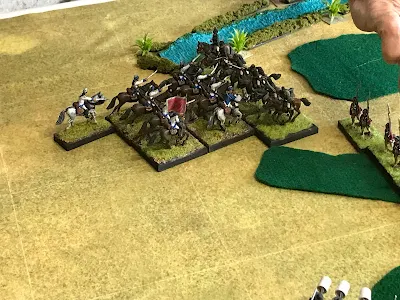To test out the rules I set up a small game that I played out solo. It was more to familiarize myself with the rules which I have not played in along time. I hope to iron out the kinks before playing with a actual opponents. Again, I plan on using the rules pretty much straight out of the box with a few variables I mentioned last post.
A small company of colonial militia are tasked with escorting a supply wagon to a garrison house. The company had ten figures and there is another ten figure company within the house. They cannot leave the house until they hear gunfire. The company is marching up the road with five figures in front and five figures behind the wagon.
Set up in the woods to both sides of the woods are three Native Warrior bands of ten figures each. They will not reveal themselves until the firing phase.
The wagon and its escort move up the road unaware of the danger. Although there is the spotting rule I have cut back the distance to half. They then roll a D6 and spot the enemy on a 4-5-6. This is due historically the colonial inability to find a ambush force before it found them!
The first two cards drawn in the firing phase are red! musket fire from the woods hit three figures who are wounded. When a black card is drawn the return fire hits one warrior. I am using the charts from the rules as is. Egyptian infantry for colonist militia and the Pathan chart for native warriors. I am not worried too much about ranges.
Next turn the wagon and its escort race up the road. They use a charge move. For the game I will take stragglers for a charge move to an object or to simulate a run. When charging opponent for close combat I don't worry about it. The militia from the house move out to support the wagon. The two warrior bands move forward also.
At the start of the firing phase the third warrior band revels itself and its fire kills the leader of the wagon train escort. But fire from the militia from the house kills or wounds wounds half of the band (good die rolling!)
In the moral phase both the wagon train escort and third warriors band fail their morale. The warriors retreats towards the ridge while the militia abandoned the wagon and race for the house. Because they failed moral I have them abandon the wagon (which is now immobile) and flee to the house. Again, because they failed moral they do not stop to carry the wounded. Its every man for himself.
Out numbered the militia from the garrison house fall back behind the stone wall in front of the house. The other two bands if warriors more closer. Both groups have a long range shoot out with no casualties but lots of smoke (Note, both groups are under cover). At this point some of the warriors charge towards the wagon. The wounded are killed and the wagon is set on fire (roll a D6 with a 5-6 start fire). Satisfied with the results they leave the field to head home and celebrate their victory.
Conclusion:
The rules came through and delivered a fun game. It struck the right balance between a skirmish and big battle game which was something I was looking for. Although the ranges for weapons might appear extreme I think they work within the terrain and size of my table. Its hard to hit a figure within cover. A future problem could be with the reduced size units. A twenty figure unit can take more casualties then a ten figure unit. But until I build bigger units these work fine.
On game balance I think both sides have their advantages and disadvantages. Both have similar weapons and similar results for firing. But the colonists have slightly better moral while the warriors can more quickly through the terrain. Its harder for the colonists to detect a ambush due to the spotting rules. With the addition of Christian Indians added to a colonial militia company that will change. Historically later in the war this is what happened and it was a new ball game.
I am most happy with the results and plan on using these rules for further battles. And comments or suggestions are welcome as thus will be a work in progress.





























































